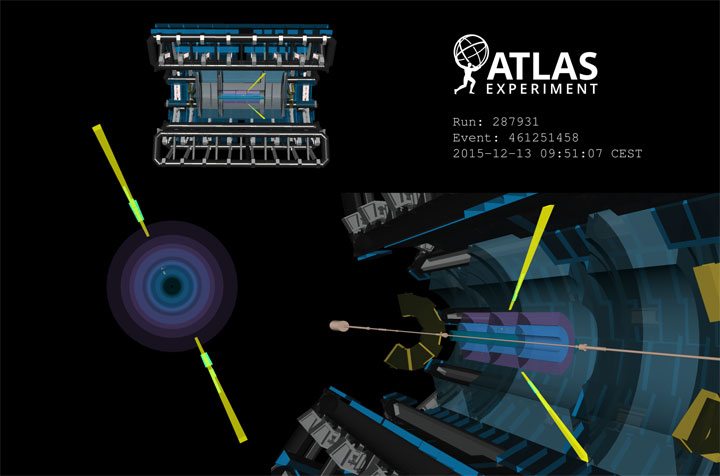ATLAS sees first direct evidence of light-by-light scattering at high energy
August 14, 2017
The following news story was posted by CERN, the European particle physics laboratory that is home to the Large Hadron Collider (LHC). The U.S. Department of Energy’s (DOE) Brookhaven National Laboratory serves as the U.S. host laboratory for the 45 U.S. institutions working on the ATLAS experiment at the LHC, and houses a central computing hub for storing and analyzing data from the experiment and distributing it to ATLAS collaborators around the world. Brookhaven scientists have also been involved in the construction of the original detector as well as upgrades for coping with higher collision rates, physics analysis, and ongoing project management and operations of the ATLAS detector. Peter Steinberg, quoted in this article, is an ATLAS physicist from Brookhaven Lab.
Geneva, 14 August 2017. Physicists from the ATLAS experiment at CERN have found the first direct evidence of high energy light-by-light scattering, a very rare process in which two photons – particles of light – interact and change direction. The result, published today in Nature Physics, confirms one of the oldest predictions of quantum electrodynamics (QED).
"This is a milestone result: the first direct evidence of light interacting with itself at high energy,” says Dan Tovey, ATLAS Physics Coordinator. “This phenomenon is impossible in classical theories of electromagnetism; hence this result provides a sensitive test of our understanding of QED, the quantum theory of electromagnetism."
Direct evidence for light-by-light scattering at high energy had proven elusive for decades – until the Large Hadron Collider’s second run began in 2015. As the accelerator collided lead ions at unprecedented collision rates, obtaining evidence for light-by-light scattering became a real possibility. “This measurement has been of great interest to the heavy-ion and high-energy physics communities for several years, as calculations from several groups showed that we might achieve a significant signal by studying lead-ion collisions in Run 2,” says Peter Steinberg, ATLAS Heavy Ion Physics Group Convener.
Heavy-ion collisions provide a uniquely clean environment to study light-by-light scattering. As bunches of lead ions are accelerated, an enormous flux of surrounding photons is generated. When ions meet at the centre of the ATLAS detector, very few collide, yet their surrounding photons can interact and scatter off one another. These interactions are known as ‘ultra-peripheral collisions’.
Studying more than 4 billion events taken in 2015, the ATLAS collaboration found 13 candidates for light-by-light scattering. This result has a significance of 4.4 standard deviations, allowing the ATLAS collaboration to report the first direct evidence of this phenomenon at high energy.
“Finding evidence of this rare signature required the development of a sensitive new ‘trigger’ for the ATLAS detector,” says Steinberg. “The resulting signature — two photons in an otherwise empty detector — is almost the diametric opposite of the tremendously complicated events typically expected from lead nuclei collisions. The new trigger’s success in selecting these events demonstrates the power and flexibility of the system, as well as the skill and expertise of the analysis and trigger groups who designed and developed it.”
ATLAS physicists will continue to study light-by-light scattering during the upcoming LHC heavy-ion run, scheduled for 2018. More data will further improve the precision of the result and may open a new window to studies of new physics. In addition, the study of ultra-peripheral collisions should play a greater role in the LHC heavy-ion programme, as collision rates further increase in Run 3 and beyond.
2017-12429 | INT/EXT | Newsroom










